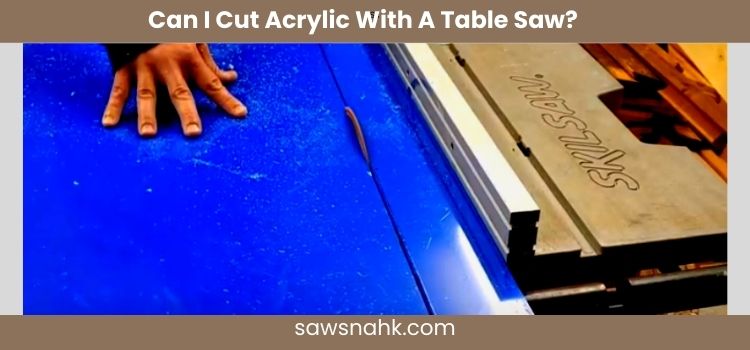Can I cut acrylic with a table saw? Ultimate Guide

Can I Cut Acrylic with a Table Saw? Yes, you can cut acrylic with a table saw, but you need to make sure you have the correct blade for the job. The right blade will have fine teeth and be designed specifically for cutting plastic or acrylic materials. Using a blade designed for cutting wood will likely result in a rough and jagged edge.
The purpose of the blog post could be to provide step-by-step instructions on how to safely and effectively cut extruded acrylic sheets using a table saw, as well as tips for achieving a smooth, clean cut. You will get valuable information on a specific topic you may need help finding elsewhere.
Tips To Get the Most Out Of Table Saw For Acrylic Cutting
Here are some tips to get the most out of your table saw for acrylic cutting:
Choose the Right Blade
Choosing the right blade for cutting acrylic is crucial. A cross-cutting carbide-tipped blade with 40 or more teeth will provide a smooth, clean cut. On the other hand, a ripping blade is not recommended for cutting acrylic sheets as it can cause the material to crack or chip. When selecting a blade, ensure it is compatible with your table saw.
Adjust the Speed
The speed of the blade also affects the quality of the cut. For cutting acrylic, it is recommended to use a slower speed to prevent cracking or melting. You can adjust the speed on most table saws by changing the blade pulley size or the motor speed.
Secure the Material
A simple solution to prevent acrylic from moving or slipping is to use clamps to hold the material in place while cutting. Another option is to use a hold-down device that can be attached to the table saw. This will help keep the material stable and prevent any potential accidents. You can transition to finer grit sandpaper as the plexiglass gets smoother and smoother.
Make the Cut Slowly and Steadily
To get the best results when cutting acrylic, take your time and cut slowly and steadily. A slow, steady cut will produce a cleaner and more precise edge than a fast, rushed cut. It is also important to avoid applying too much pressure, as this can cause the material to crack or chip. Let the blade do the work, and make sure to keep your hands clear of the blade at all times.
Can You Cut Acrylic Plexiglass With A Table Saw?
Yes, you can cut acrylic plexiglass with a table saw, but you need to use a fine-toothed, cross-cut blade and keep the saw speed low to avoid melting the material. Additionally, using a scoring blade before cutting can help prevent cracking. It’s also important to keep the acrylic securely clamped to the table to prevent it from bending or warping while cutting.
Can You Cut Acrylic With A Wood Saw?
No, a wood saw is not suitable for cutting acrylic. Acrylic is a type of plastic that is harder and more brittle than wood, and using a saw designed for cutting wood can result in cracking or chipping of the acrylic. A fine-toothed or special saw blade designed for cutting plastic is recommended when cutting acrylic. A polished acrylic edge cannot be glued.
How Do You Cut Plexiglass On A Table Saw?
Step 1: Preparing the Plexiglass:
To design a scroll saw pattern, you must simplify the image. It should be in black or white. Because white itself is the wood, and black represents the void or blank cut out of the wood. Creating a new pattern or cutting is the first step in scroll saw crafting. Here are some results of impact resistance tests done on the Plexiglas brand plexiglass compared to other types of glass.
Step 2: Choosing the Right Blade:
Choose a fine-toothed cross-cut blade for cutting plexiglass. This blade type is designed to make precise cuts and reduce the risk of cracking or damaging the plexiglass. Make sure the blade is sharp and secure in the saw. Always pay attention to table saw blade thickness for best results.
Step 3: Cutting the Plexiglass:
Start the saw and gradually lower it until the blade cuts the acrylic plexiglass sheet. Use a straight-edge guide to keep the cut straight and a push stick to help guide the plexiglass through the blade. Move the plexiglass slowly through the blade, and once the cut is complete, turn off the saw.
Can you cut an acrylic sheet with the utility knife?
Yes, you can cut an acrylic sheet with a utility knife, but it may require multiple passes and can create rough edges. Using specialized tools such as a saw or a scoring knife is recommended for a cleaner and smoother cut. For instance, with a thin sheet, 1/8th of an inch, you can use a plexiglass knife or even a utility knife.
Consider sanding the cut edge with a sanding block or buffing pad for a polished edge. A circular saw or utility knife can also cut acrylic, but a table saw with the correct blade may provide a cleaner and more precise cut.
Conclusion!
In conclusion of Can I Cut Acrylic with a Table Saw? It is possible to cut acrylic with a table saw. Still, it requires special considerations to avoid damaging the material. A blade with fine teeth, a low tooth count, a slow feed rate, and proper support will help produce clean and accurate cuts. Using a score and snap method with this kind of plastic sheeting is usually better.
FAQs.
Is Acrylic Difficult To Cut?
Acrylic can be difficult to cut without cracking because it is brittle. Acrylic plastic sheets are a relatively soft but can be brittle and prone to cracking or breaking if not cut correctly. Cutting acrylic requires sharp blades and a steady pace to avoid cracking.
How Do You Cut Acrylic Without Cracking It?
First, score the acrylic along the cutting line with a sharp blade and use a straight edge or ruler as a guide to ensure a clean and straight. Apply even pressure to both sides of the scored line and bend the acrylic until it snaps. To remove rough spots, smooth the edges with sandpaper or a polishing wheel.
Does Acrylic Crack Easily?
Acrylic can crack under certain conditions, such as if it is subjected to high stress or impact, exposed to excessive heat, or made with a low-quality formulation. However, the acrylic plastic sheet is a strong and durable material resistant to cracking when used properly and under normal conditions.
